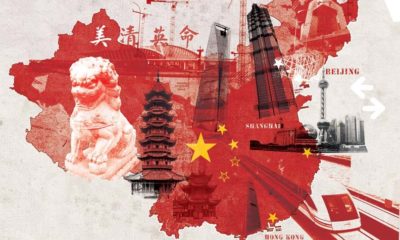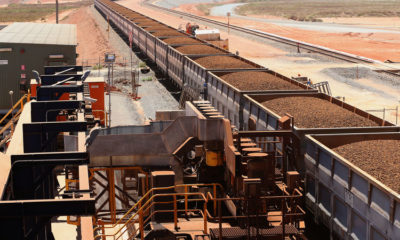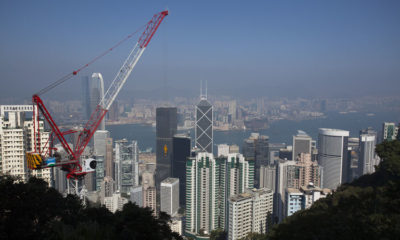- China Roars Back to Lift Global Outlook as U.S. Consumer Weakens
China’s economy stormed back in the first quarter, clocking its first back-to-back acceleration in seven years and bolstering the global growth outlook just as signs of subdued consumer spending have surfaced in the U.S.
The Chinese economy accelerated to a better-than-expected 6.9 percent, powered by strength in housing, infrastructure investment, exports and retail sales. And it looks to have done so without worsening credit risks, a welcome development for economists worried about the nation’s towering debt burden.
The world’s second-biggest economy accounted for about one-third of global growth last year and, given the strong first quarter data, is on track to contribute at least as much in 2017, according to Rob Subbaraman, chief economist for Asia ex-Japan at Nomura Holdings Inc. in Singapore.
“China, at least in the near term, is in a sweet spot with growth momentum strong and inflation pressures easing,” said Subbaraman. “Whichever way you dice it, the first quarter was a strong set of numbers.”
The robust economic showing is an auspicious start to a politically eventful year for President Xi Jinping and Premier Li Keqiang, whose government has set a growth target of 6.5 percent or above. Policymakers are bent on steady growth to ensure a smooth leadership reshuffle expected later this year.
Rebalancing
The Chinese economy is in the midst of a major structural shift away from its past reliance on heavy manufacturing and export-led growth toward services and consumer demand. Officials are also trying to avert a trade war with the U.S., manage capital outflows amid depreciation pressure on the yuan, and slow the growth of household, corporate and government debt.
For the world economy, the Chinese rebound may deliver positive second-round effects.
“Emerging markets will benefit from this strength in Chinese growth firstly through commodities demand and support for commodity prices,” said Rajiv Biswas, Asia-Pacific chief economist at IHS Markit in Singapore. “Secondly, the whole Asian manufacturing supply chain will get a boost from stronger Chinese growth.”
China’s imports from the Association of Southeast Nations surged 22.7 percent in March from a year earlier while those from Singapore were up 41.5 percent. From commodities exporter Australia, imports jumped almost 75 percent.
The first-quarter expansion came as the real estate market shrugged off policy constraints, exports surged and retail sales rebounded. Economic growth in March from a year earlier jumped to 7.6 percent, up from 7 percent in February, according to a Bloomberg Intelligence gauge.
Financial risks also were contained as nominal growth rose at the fastest pace since 2012 — 11.8 percent in current-price terms — making the problem of excess leverage look a little more manageable, according to Tom Orlik, chief Asia economist at Bloomberg Intelligence in Beijing. Total credit reached about 258 percent of economic output last year, up from 158 percent in 2005, according to Bloomberg Intelligence estimates.
Debt Growth
Debt financing expanded about 12 percent, roughly on par with nominal GDP growth, said William Adams, senior international economist at PNC Financial Services Group in Pittsburgh, who previously worked for the Conference Board in Beijing. In recent years, overall debt growth had been expanding faster than the overall economy.
“This is a big deal,” he said. “The gap between nominal GDP growth and credit growth was often cited as the strongest quantitative argument that China’s growth model is unsustainable. If credit growth remains moderate as it has been since mid-2015, and nominal GDP growth continues at its current pace or picks up, this vulnerability in China’s growth model will seem less urgent.”
China’s acceleration comes as U.S. inflation took a surprising step back in March at the same time as retail sales dropped for a second month, according to reports Friday. While the pullback at retailers underscored a weak first quarter for consumer spending that economists had already penciled in, the inflation data are what surprised given recent signs that businesses had been able to regain pricing power.
A further cooling of price pressures and modest household demand would raise questions about whether the economy could withstand a mid-year move by the Federal Reserve to lift borrowing costs.
Not all the news is good. The downside to China’s acceleration is its reliance on an old formula: growth driven largely by credit-fueled investment in infrastructure and property.
“The first quarter figure is undoubtedly upbeat and encouraging and it seems to have changed the short-term sentiment substantially,” said Zhu Ning, author of “China’s Guaranteed Bubble” and deputy director of the National Institute of Financial Research at Tsinghua University in Beijing. “But a large part of growth is achieved by another unprecedentedly large fiscal stimulus, infrastructure investment, and debt escalation, which is currently being camouflaged by increasing housing prices and land values,” he said.
Global Demand
Trade tensions with the U.S. under President Donald Trump may also deteriorate again if a “100-day plan” to discuss trade fails to yield results.
Though global demand will remain conducive and infrastructure investment will be robust in this political year, domestic momentum overall will ease in the second half, said Louis Kuijs, head of Asia economics at Oxford Economics in Hong Kong. That’s because measures to curb house purchases in many large cities will start to weigh on real estate investment.
For now though, China’s expansion is a welcome boost for a global economy that’s still navigating a fragile recovery as it shakes off a hangover from the global financial crisis.
“The upturn in Chinese growth is a very positive indicator for the Asia Pacific and world growth in 2017, as well as underpinning the near-term outlook for global commodities,” said Biswas with IHS Markit.


 Forex2 weeks ago
Forex2 weeks ago


 Naira2 weeks ago
Naira2 weeks ago
 Naira4 weeks ago
Naira4 weeks ago
 Billionaire Watch1 week ago
Billionaire Watch1 week ago
 Company News4 weeks ago
Company News4 weeks ago




 Naira2 weeks ago
Naira2 weeks ago




 Naira1 week ago
Naira1 week ago




 Naira4 weeks ago
Naira4 weeks ago





















